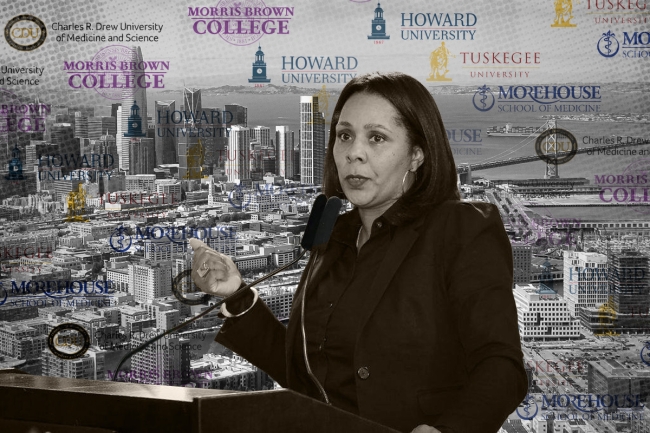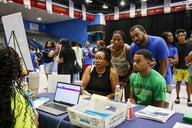You have /5 articles left.
Sign up for a free account or log in.

Sheryl Davis, director of San Francisco’s Human Rights Commission, said plans for an HBCU satellite campus in the Bay Area are more tangible than ever.
Photo illustration by Justin Morrison/Inside Higher Ed | City of San Francisco | Getty Images
California is one of 31 states that lack a historically Black college or university, but civil rights advocates in San Francisco are hoping to change that by partnering with an existing HBCU to open a satellite campus there.
The plan is still in its exploratory stages, but the city’s Human Rights Commission held a summit with HBCU and local university administrators on Feb. 2 to discuss the idea further. Mayor London Breed was also at the event and has voiced support for the project.
Sheryl Davis, executive director of the city’s Human Rights Commission, who is leading the effort, explained that various community groups have discussed bringing an HBCU campus to the area in the past, but the plans never came to fruition for a variety of reasons.
In order to formally qualify as an HBCU, the Higher Education Act of 1965 states that an institution must have been established prior to 1964, which puts the concept of an entirely new HBCU off the table. But Davis said plans for a satellite campus are back on, and this time they’re more tangible.
“There are two university administrators that are all in and have already started to do some follow-up,” Davis said. Although the administrators themselves are eager to move forward, they are not authorized to announce any commitment without the approval of the boards of their universities.
HBCUs are predominantly located in southern U.S. states, and those that were represented at the meeting earlier this month include Morris Brown College and Morehouse School of Medicine in Atlanta, Tuskegee University in Alabama, and Howard University in Washington, D.C. Administrators from Charles R. Drew University of Medicine and Science, a historically Black graduate school in Los Angeles, also attended.
Although the Human Rights Commission has yet to formalize a budget for opening a new branch, officials anticipate significant financial support from the Dream Keeper Initiative, a citywide fund launched in 2021 to reinvest $60 million annually into San Francisco’s Black communities. The commission has scheduled a meeting for later this week with the city budget office to discuss finances further.
Davis said the next formal meeting with the HBCU administrators will be held in Washington, D.C., in March followed by a convening at the African American Mayors Association conference in Atlanta in April. She expects that if the planning process maintains its current pace, the satellite campus could be launched as early as spring 2025.
“People were coming together from across the country and across industries to say, ‘We’ve got to do this. We’ve got to build something. We want to be a part of this,’” Davis said. “That’s energizing.”
An Opportunity for Revival
The most recent discussions about a San Francisco satellite campus emerged from a reparations committee established after Minneapolis police killed George Floyd in 2020. The committee is charged with addressing housing discrimination and inequities in education and access to public transit, among other socioeconomic disparities. However, calls for a Black-centered higher education institution began to bubble up among San Francisco residents long before the reparations committee was convened. And leaders of Paul Quinn College in Dallas have separately considered establishing a West Coast campus in Oakland, just across the bay from San Francisco.
Diane Gray, co-founder of 100% College Prep, a local nonprofit organization led by Black community members, has been advocating for an HBCU satellite campus since 2017, when she was appointed to a city commission focused on the development of a new community center for the city’s southeastern districts.
Gray had led a series of annual in-state college tours for city students since 1998. But she didn’t know much about the HBCU experience until the organization started sponsoring cross-country campus visits.
“We began to see how important it was to our young people to be able to see and be encouraged and engaged by young Black college students in their element on campus,” she said. “We saw and we heard how many of our middle and high school students asked more questions of program alumni who attended HBCUs.”
But not all students could afford out-of-state or private tuition. So Gray proposed to the neighborhood commission the creation of a HBCU “education hub.” Although the idea didn’t stick then, she thinks it’s “quite possible” it will now.
“We’re having this conversation that I think really is on a larger scale,” Gray said.
City officials have also endorsed the plan and view the satellite campus not just as an academic opportunity but an economic one that could help revive a once-bustling downtown district that is now emblematic of post-pandemic ghost towns.
Shamann Walton, an alum of Morris Brown College and a member of the San Francisco Board of Supervisors, said drawing a HBCU to the city “could be big” for filling vacant spaces.
“And it’s definitely a spark and catalyst for other economic developments,” Walton added. “Restaurants, stores, pharmacies, other businesses that are in the same area—that’s a boost for them as well.”
Local and state industry leaders are also trying to create diverse talent pipelines and stop the brain drain of Black students who leave California for education elsewhere.
San Francisco’s Black population has dwindled from almost 11 percent in 1990 to around 5.7 percent today. But prior to a government redevelopment plan that bulldozed swaths of homes and prompted an exodus of Black residents from the Western Addition and Fillmore neighborhoods, which were known as the “Harlem of the West,” the Black population peaked at just over 13 percent.
“It was a really thriving Black community,” said Davis of the Human Rights Commission. “Folks used to come to San Francisco for music and art and just the experience.”
While community members are urging city officials to establish the HBCU campus to revive and elevate Black education and culture, it also represents an opportunity “to get people to not just stay in San Francisco, but to actually come back,” she said.
An Opportunity for Growth
The earliest phase of the project will launch this summer, using $150,000 in state funding and a partnership with the University of San Francisco to host and provide programming for 20 to 30 HBCU “transplant students,” as well as HBCU students who are San Francisco natives and are interning in the Bay Area for the summer.
The next goal is to have a space for a full satellite campus finalized within a year and for renovations to be completed and the programming up and running six months to a year later.
Kevin James, president of Morris Brown College, who attended the recent summit, believes “it could be a great match.” He’s still waiting to learn more about the exact location, funding and approval from accreditors. “But if everything works out, we’re interested,” he said.
Morris Brown was stripped of its accreditation in 2002 following the embezzlement of federal funds and has been rebuilding a crumbling campus ever since. James said a satellite campus could be the pinnacle of its resurrection.
“For Morris Brown not only to be alive and doing much better and well in Atlanta, but then to expand and go across the country … It really could be a game changer,” he said.
Angela L. Minniefield, senior vice president of advancement and operations at the Charles R. Drew University of Medicine and Science, said the opportunity for growth also influenced her interest in a possible partnership.
The university, which was founded as a graduate school in 1966, introduced its first undergraduate program for radiology certification in 2013 and has since expanded to include bachelor’s degrees in nursing, public health, biomedical science and psychology. It currently serves just under 1,000 students, a quarter of whom are undergraduates. The goal is to double enrollment, with half pursuing a bachelor’s or associate degree.
Minniefield believes the partnership would allow Charles Drew to grow while maintaining an individualized approach that counters the trend of “academic casualties” among Black students who drop out from larger public institutions due to the lack of personalized support. In doing so, they’d foster “a workforce that looks like the population,” she said.
“There is a significant demand for health workers who represent the Black community in San Francisco, so there’s synergy,” she said.
An Opportunity for Innovation
Terrell Strayhorn, director of research for the Virginia Union University Center for the Study of HBCUs, said San Francisco is pursuing “a relatively innovative and new frontier” at just the right time.
There is an ongoing conversation, across the nation’s 103 HBCUs, about expanding the sector’s footprint, and “it’s probably two or three headwinds that are coming together,” Strayhorn said, referring to enrollment demands, limited campus capacity and small endowments, which have led to a dependency on tuition. Satellite campuses, in many ways, can help address such challenges by providing a new space for additional students and increasing the tuition received each year.
He noted that although a growing number of HBCUs have announced or implemented branches in regions near their main campuses, few institutions have explored venturing across the country.
“Today, when you have more people across the nation, not just in the Southeast, who want the HBCU experience,” Strayhorn said, “I don’t think we should be terribly surprised that there’s both an opportunity and likely a need on the West Coast.”
Felecia Commodore, a scholar of HBCU leadership, governance and administrative practices, drew similar conclusions.
“There’s been research and evidence that a number of students in California want to be at a school where they are not the minority,” Commodore said. “But most of your HBCUs do reside on the East Coast and [in] the southern part of the United States, which is, for all intents and purposes, all the way across the country.”
“What having a satellite option allows is the possibility to create that experience for students who may not have the resources to go across the country,” she added.
Strayhorn said the biggest question that remains is can one replicate the very HBCU culture and ethos that has attracted so many students?
“When students talk about having an HBCU experience, they’re talking about coming to a place where, you know, Black lives have always mattered, where they can come into a space and see Black excellence, cultural representation and a deep, profound kind of appreciation for diversity as the order of the day,” he said. “So the question becomes, how do we do that?”




